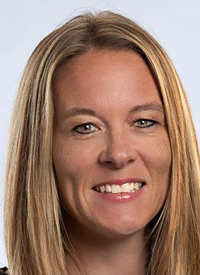Remote Patient Monitoring for CAR T Demonstrates Feasibility in the Outpatient Setting
During the 2023 Tandem Meeting, Trista Carelock RN, BSN, ONC, BMT-CN, highlighted how her institution leveraged remote patient monitoring to offer outpatient CAR T-cell therapy to patients.
Trista CarelockRN, BSN, ONC, BMT-CN

Remote patient monitoring (RPM) may serve as an effective tool in allowing patients to safely receive CAR T-cell therapy in the outpatient setting , according to Trista Carelock RN, BSN, ONC, BMT-CN. RPM permits nurses to safely measure and manage adverse events (AEs).
Data presented from a pilot study at the 2023 Tandem Meeting demonstrated that in 4 participating Sarah Cannon network programs evaluating RPM in the outpatient setting, 40 patients were successfully treated without a serious adverse event (AE). Among those who did experience an AE, 26 needed to be admitted to the hospital. Twenty-seven patients developed cytokine release syndrome (CRS) and 7 were diagnosed through RPM. The maximum grade at time of diagnoses was 2. Neurotoxicity was experienced by 14 patients, again all cases were grade 2 or lower at time of diagnosis. No cases of neurotoxicity were diagnosed via RPM.
“These therapies are associated with potentially life-threatening risks including CRS and neurotoxicity” Carelock, the director of Transplant & Cellular Therapy Clinical Programs at Colorado Blood Cancer Institute at Presbyterian/St Luke’s Medical Center, an affiliate of the Sarah Cannon Transplant and Cellular Therapy Network, said in a presentation of the findings. “RPM plays an important role in providing outpatient therapy by offering a mechanism for healthcare teams to monitor the patient in their local environment.”
Additionally, through RPM there were more than 150 high alerts triggered, which Carelock attributed to beginning with too wide parameters. “Once we narrowed those parameters, it significantly reduced the number of alarms that we were getting.”
As CRS and neurotoxicity remain life threatening AEs of CAR T-cell therapy, this pilot program assess the feasibility of outpatient CAR T-cell delivery. The 4 programs included in the study were the Colorado Blood Cancer Institute at HealthONE’s Sarah Cannon Cancer Institute at Presbyterian/St Luke’s, Sarah Cannon Transplant & Cellular Therapy Program at Methodist Hospital, San Antonio, Sarah Cannon Transplant & Cellular Therapy Program at St David’s South Austin Medical Center, and Sarah Cannon Transplant & Cellular Therapy Program at TriStar Centennial. Ten patients participated in each program.
The immune effector cell therapy (IECT) coordinator was used to screen patients for eligibility. Patients with high comorbidities and high tumor burden were excluded during enrollment and nurses worked with physicians to find candidates for RPM. Caregivers were aged 18 years or older with a valid driver’s license and reliable transportation.
Outpatient monitoring included biometric measurements and answering pathway questionnaires identify issues and concerns 2 to 3 times daily, which all patients complied with. These data and responses were uploaded onto a dashboard nurses could evaluate on the computer for side-by-side viewing with a clinical overview. Biometric data included temperature, blood pressure, heart rate, weight, and pulse oxygenation. Patients also participated in daily video assessments with a nurse.
“The pathway questions included questions such as have you experienced any new signs or symptoms of problems, what is the current year, have you experienced a fever with or without chills, dizziness, or difficulty remembering places you have been or people you know?,” Carelock said.
Moreover, patients came to clinic for the first 14 days of treatment daily and then visits tapered off to coming in 2 days per week with RPM occurring through day 30. Challenges included false alerts, lack of a mobile application, a platform update which impacted video capabilities, and the resources needed during and after clinic hours to manage the RPM.
After the monitoring period was over a survey, which 26 patients participated in, determined that 25 respondents felt more comfortable knowing a nurse was checking their health every day and 24 respondents would recommend monitoring to others.
Carelock noted that the original dashboard was only monitoring patients from 7:00 am until 8:00 pm, and patients would log their vital signs at 7:00 am after the hiatus. As resources were an issue, a new system is being adopted at Sarah Cannon with RPM and an on-call physician will be able to assist if the patient has changes.
“Due to this [gap in monitoring] we are moving to another vendor to manage RPM,” Carelock said. “This new vendor offers 24/7 monitoring of our patients which reduces the workload of our staff.”
“The biggest thing is to think about the resources that are utilized and to make sure that whoever you chose to monitor system [has the] bandwidth to do that because it is a lot,” Carelock concluded. “We had our clinic nurses doing that and they’re very busy so sometimes it would take them a little bit to get back to the dashboard to look at it. Being mindful of who you choose [is important] so that those resources have enough time to be successful in monitoring the patient.”
Reference
Carelock T, Brooks KA, Haga B, et al. Utilizing remote patient monitoring to safely manage chimeric antigen receptor t- cell therapy patients in the outpatient setting. Presented at: 2023 Tandem Meetings and Transplantation & Cellular Therapy Meetings of ASTCT and CIBMTR; February 15-19, 2023; Orlando, FL.
Shared Model of Care Post-HCT Offers Safe Follow-Up, Reduces Patient Burden
Published: March 19th 2025 | Updated: March 19th 2025Alternating post-HCT care between specialized facilities and local cancer centers produced noninferior non-relapse mortality and similar quality of life to usual care.


